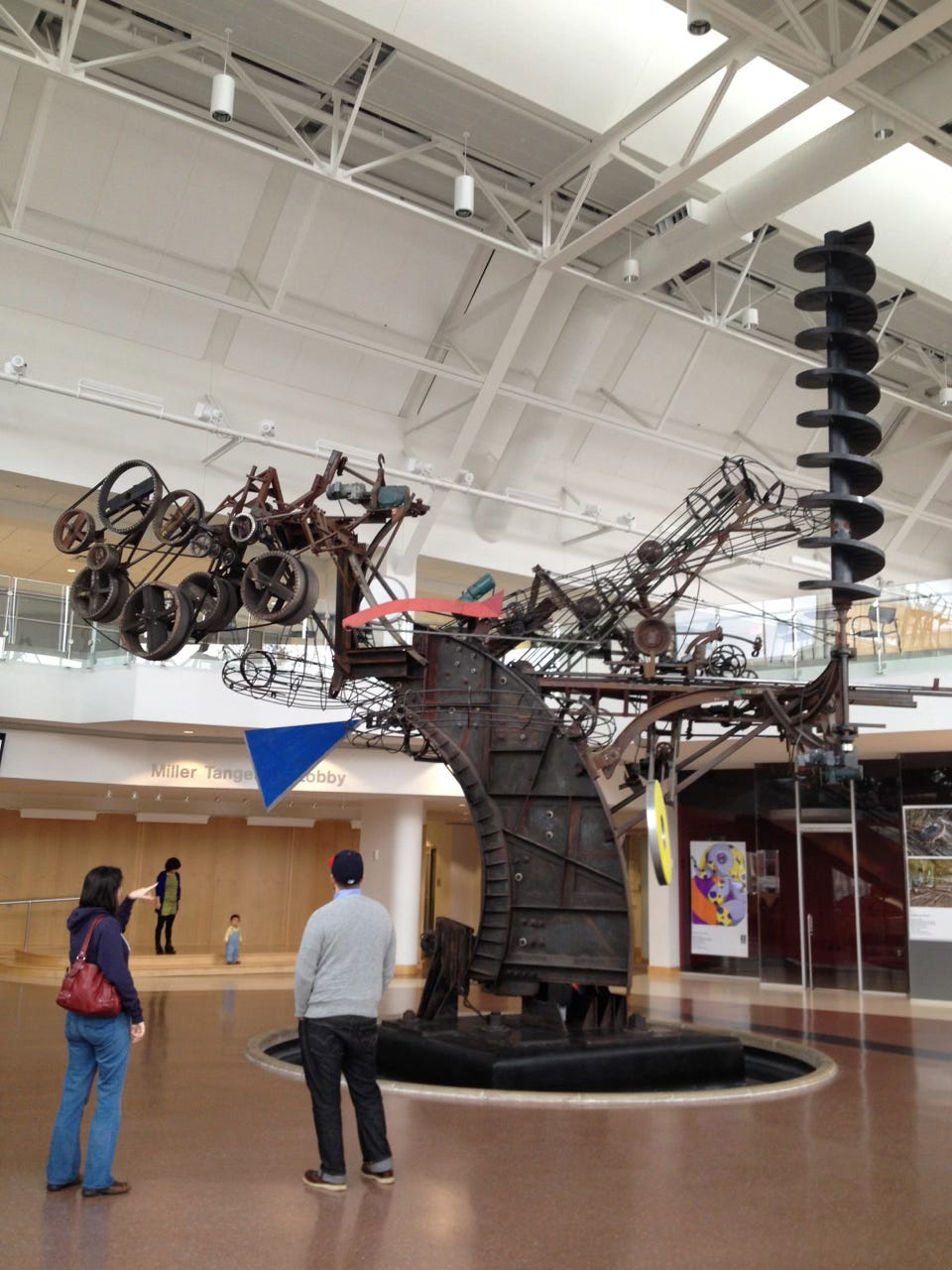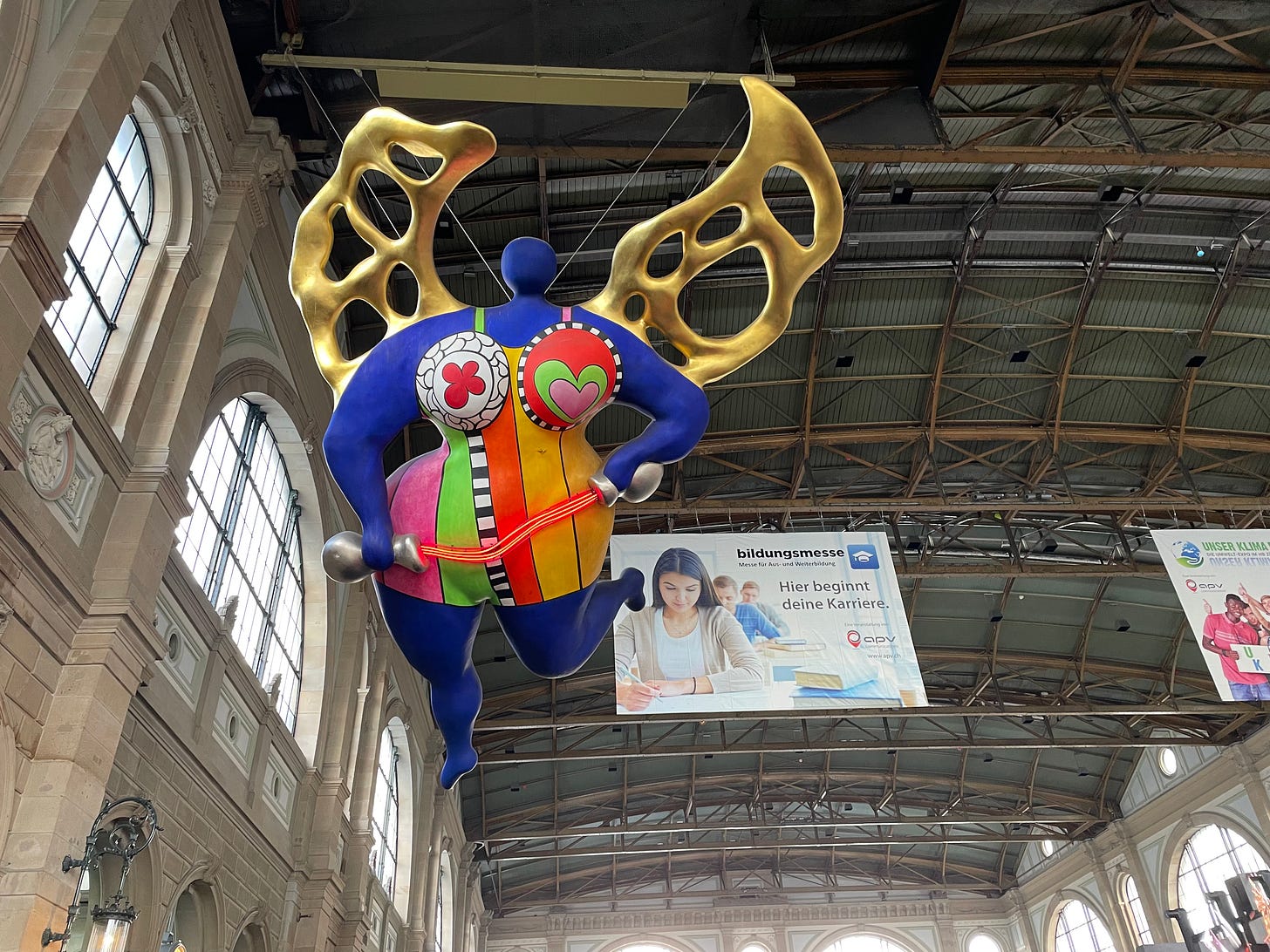Yesterday, May 22nd, was the 100th anniversary of Swiss artist and sculptor Jean Tinguely’s birth. To celebrate, Basel’s Museum Tinguely had a birthday party, complete with cake.
Museum Tinguely is one of my favorite Basel art museums. It opened in 1996, five years after Tinguely’s death. I first visited in 1998 and immediately fell in love with Tinguely’s kinetic work: found objects, rusty farm equipment, a piano keyboard, garden gnomes, all welded together into giant sculptures, at least one of which visitors could climb on. By standing on a button, you could make the moveable parts move, filling the museum hush with creaking, clanging, banging.

I say “fell in love,” as though July 31, 1998 (I still have the ticket, in a scrapbook) was the first time I encountered Jean Tinguely’s work. The Tinguely fountain is a Basel landmark, one our tram route passed every time we went into town. The Swiss post office released a Tinguely stamp in 1988, and a pair made it into my collection (scrapbooks and stamp collections: welcome to my youth). Tinguely’s Luminator sculpture hung in the Basel train station lobby between 1991 and 1998. It’s now in the Basel airport (in France), in an event space on the uppermost level in the check-in hall. If you know where to look, you can spot it when you’re checking in, but it’s inconvenient, and who goes out of their way for art before security?
There was a movement to reinstall Luminator in the train station in time for the 100th anniversary, but the Basel government has announced that for “structural and operational reasons,” it’s not going to happen. I hope the search for a Basel location continues.
Every time I go to an art museum, I look at someone’s work and think, “I’d like to read a book about this artist’s life.” If I’m lucky, I finish the Wikipedia article, which is how I know Max Ernst was married to Peggy Guggeheim.
I did read the whole Jean Tinguely bio on the museum’s website, which may be enough. I learned a few things, like:
Tinguely was born in Fribourg but moved to Basel when he was three. He did his apprenticeship in decorating at Globus, a Swiss department store that remains in business today. They fired him and informed his father of his firing via a letter.
“Der junge Mann macht ständig Dummheiten,” the letter says: the young man is constantly doing stupid things. He apparently also damaged materials. Sometimes on purpose.
Tinguely finished his apprenticeship with an independent decorator, then went on to Basel’s Kunstgewerbe school (School of Arts and Crafts). He had the following take on the modern art he encountered there:
“It wasn’t easy to comprehend and perceive the being of Marcel Duchamp.” Agreed! Granted, the only Duchamp work I can call to mind is his urinal.
Tinguely met his first wife, Eva Aeppli, at school. After his studies, he worked as a window decorator in Basel. The couple moved to Paris in 1952, wherever he gradually gained recognition. In 1955, he had four kinetic sculptures in a group show called “Le Mouvement”. The show also included work by Alexander Calder and Marcel Duchamp (not the urinal).
In 1959, Tinguely created his Méta-Matic drawing machines and presented one at the first Paris Biennale that October. Méta-Matic No. 17 drew, moved around, squirted lilac scent, and inflated a balloon until it popped.
Tinguely made his U.S. debut in 1960, in the Museum of Modern Art’s sculpture garden, with an auto-destructive sculpture called Homage to New York. In 1973, Indiana-based engine manufacturer Cummins, Inc., commissioned a sculpture for the Commons mall in Columbus. Chaos I remains in that mall; I’ve made a detour to see it.
In 1977, Tinguely and a collective called Zig et Puce created Crocodrome, a 30-meter-long, 10-meter high dragon-like sculpture to mark the opening of the Centre Pompidou in Paris. It included a ghost train (this is not a term I’m familiar with, but it seems to be a chill rollercoaster. Like the Peter Pan ride at Disney World in the 1980s?). Six months later, they destroyed it.
One of the artists in that collective was Niki de Saint Phalle, by then Tinguely’s second wife. Her work is part of the reason I like him; she brings color to their collaborations. Her work stands alone, though I’ve seldom seen a solo Niki exhibition. She deserves her own ReSwissed entry, but this is Tinguely’s 100 birthday.
Even if Crocodrome is gone, if you’ve been to the Centre Pompidou or even just walked near it, you may have seen Tinguely and De Saint Phalle’s work, as they collaborated on the Fontaine Stravinksy. He’s the black bits; she’s the color.
In the 1980s, Tinguely started incorporating bones and animal skulls into his sculptures. The Museum Tinguely’s presentation of some of these pieces is effectively creepy: dark room, lighting that creates looming shadows of animal skulls. Tinguely apparently also loved Formula 1 and made at least two sculptures in honor of different deceased race car driving friends. These sculptures also use animal bones.
***
There are exhibits marking the Tinguely centenary in Fribourg, Paris, and Somerset, England this year, should those spots be closer to you.
Should you ever make it to Basel, in this 100th anniversary Tinguely year or later, make time for Museum Tinguely. It’s also the starting point for the full stretch of a Rhine swim, so you could combine two Basel icons in one go. The gift shop almost always has Wickelfish for sale.
Sources
“Der «Luminator» von Jean Tinguely hat keinen Platz mehr am Basler Bahnhof.” BaZ.
“Jean Tinguely: life and work (1925–1991).” Museum Tinguely.
“Kinetic Energy: Events Across Europe and the U.S. Celebrate Jean Tinguely Anniversary.” The Art Newspaper
“Luminator.” This is Basel.







Love this! And thank you for sharing art with us. Just heard a podcast about good health and ART is one of its pillars. I’ve been thinking about that as I start the retired phase of life. Art like you talk about here inspires AWE and that’s good for the soul. I’m not being very eloquent. Just want to affirm your posts like this.